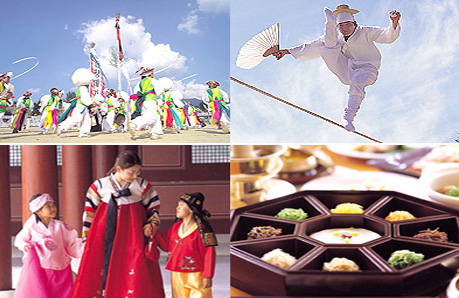
Literally meaning "autumn evening," Chuseok is one of the two major traditional holidays in Korea along with Seollal, Lunar New Year's Day.
It is celebrated on the 15th day of the eighth lunar month, during the harvest season when the moon is full and the grains and fruits are all ripened.
Chuseok has long been the day on which Koreans thank their ancestors for the year's harvest by offering them rice, fruits and other things from the harvest bounty, and by sharing their abundance with family and friends.
This day is also referred to as hangawi, which means the very middle of August, or August 15th according to the lunar calendar.

It comes when the moon is full and brightest, and it was picked to thank the ancestors because in traditional Korea, where farming was the main foundation of society, the moon symbolized the earth and the goddess of all life.
The practice of celebrating Chuseok dates back to the early Silla Dynasty (57 B.C. - A.D. 935).
In the year A.D. 32, King Yuri of Silla ordered women from six local towns in Gyeongju, the capital of the ancient dynasty, to be divided into two teams and to engage in a weaving competition over the period of one year from July 15 until August 14 the next year.
The team that had woven the most cloth by the date we now know as Chuseok was declared the winner.
The losing team would then prepare a large celebration - filled with dancing, eating and singing - for the victors.
Although the outcome of the competition was for the winner to be served by the losing team, everyone enjoyed the feast, celebrating with songs and dance.
This year, Korea's most famous traditional holiday of Chuseok falls on September 14 of the solar calendar.
During the holiday, there will be a mass exodus from cities as millions of Koreans return to their ancestral hometowns to reunite with their families and to pay homage to their forebears.

People visit the tombs of their ancestors on Chuseok.
On Chuseok day, people perform ancestral worship rituals early in the morning.
The traditional ceremonies of beolcho, charye, and seongmyo are faithfully practiced by a large portion of the Korean population.
On the morning of Chuseok, songpyeon (a type of Korean rice cake prepared with rice or non-glutinous rice powder that is kneaded into half-moon shapes and filled with sweet filling) and food prepared from that year's fresh harvest are arranged to give thanks to the ancestors through the charye (ancestor memorial service).
After the charye, the family members sit down together at the table to enjoy some delicious food.
Then, they visit the tombs of their ancestors and make a formal bow of gratitude, a practice known as seongmyo, and then they trim plants, cut the weeds and clean the area around the tomb, the practice called beolcho.
After the rites, people play folk games like ssireum, Korean-style wrestling, and tug-of-war during the daytime, while they do moon-greeting and ganggang-sullae dance (Korean circle dance) on Chuseok evening.
In the ganggang-sullae dance, groups of girls form a circle and start moving clockwise and then counterclockwise around a solo singer who dances and sings the refrain, "ganggang-sullae," in the center of the circle, which means "watch your surroundings."
There is no clear record of how the circle dance began, but it has been circulated that it was created during the invasion of Korea by Japan in 1592.
Back then Admiral Yi Sun-shin ordered the women of a nearby village to build fires on the mountaintops and to dance in rings around the flames in a strategy to make the Japanese believe that the Koreans had a greater number of soldiers at hand than were actually present.
In a word, Chuseok is supposed to be the season of abundance, generosity and sharing.
To live up to that spirit of sharing and generosity, four major palaces in central Seoul, public parks with royal tombs, and other cultural sites are open at no cost during the holiday.
Also during the entire holiday period, entrance is free of charge at national museums for those wearing the traditional Korean costume, Hanbok.
By Han Aran
Korea.net Staff Writer